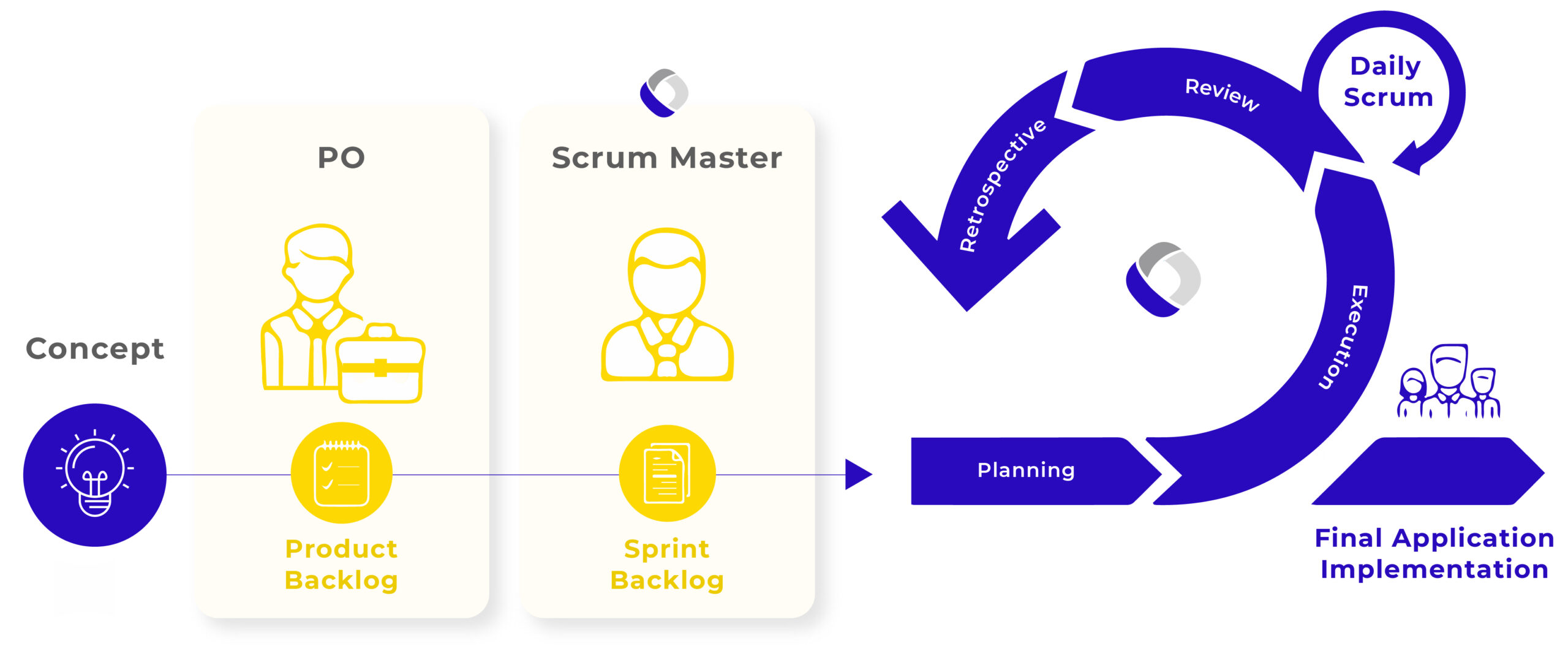LOW CODE & TECHNOLOGY
Glossary of the Agile method
February 13, 2023

Usually, when running a project in a company, the smallest details are set out from the outset in an often tedious set of specifications. But things rarely go according to plan, and over-rigid planning can actually be counter-productive. This is the premise of the Agile method, which gives full rein to change and changing needs. Let’s take a closer look at what the Agile method is all about, with an overview of its lexicon: values, players, processes and key rituals.
Adopt the Agile mindset
Known as the “Agile method”, this new approach to project management is much more than just another fashionable procedure. Because it is based above all on the values and principles set out in the 2001 Agile manifesto, the Agile method can be likened to a state of mind, or even a philosophy.
Values
The Agile Manifesto recognizes the value of the second elements outlined in the 4 sentences below, but emphasizes :
• Individuals and interactions more than processes and tools.
• Operational software than exhaustive documentation.
• Collaboration with customers more than contractual negotiation.
• Adaptation to change more than sticking to a plan.
Understand that implementing the Agile method does not mean that it is no longer necessary to establish a plan or document one’s work.

« More than a method, agility is a mindset that allows for quicker adaptation to change by placing communication at the heart of the project. »
The principles
The Agile Manifesto outlines 12 principles that illustrate the 4 values mentioned above.
-
- Customer satisfaction is the highest priority. This needs to be addressed through rapid and regular delivery of high value-added features.
- Welcoming changes and new needs positively, even if they arise when the project is already at an advanced stage.
- Deliver working software frequently, with cycles ranging from a few weeks to a few months, with a preference for shorter cycles.
- Build projects around motivated individuals. Give them the environment and support they need, and trust them to get the job done.
- Work on projects with motivated individuals who are given the environment and support they need, and trust them to get the job done.
- Prioritize face-to-face communication to convey information to the development team and within it.
- A working product is the primary measure of progress.
- Establish a sustainable, steady pace to drive the project forward.
- Pay continuous attention to technical excellence and good design.
- Simplicity – the art of minimizing unnecessary work – is essential.
- Empowering teams: the best architectures, specifications and designs emerge from self-organized teams.
- Think about how you can become more efficient at regular intervals, then adjust your behavior accordingly.

Agile team: roles and responsibilities
The individual is at the heart of the agile method’s values, so it’s only natural that we should introduce you to the team before anything else.
The Product Owner (PO)
The Ower Producer is responsible for the value of the product delivered by his team. He prioritizes topics in order to organize the “Backlog” and writes the “User stories”, two terms we’ll explain a little further down in the article. The Product Owner is also the link between the technical teams responsible for developing the product and the customer who has expressed his or her needs.
The Scrum Master
The Scrum Master is the guarantor of compliance with the Scrum methodology, and in particular with the rhythm set by the Sprints and the tasks to be carried out in the Backlog. He combines the qualities and skills of a coach and a project manager, although he does not initiate the design of the project.
By the way, can you tell the difference between “Agile” and “Scrum”, which are often wrongly presented as synonyms? In fact, Scrum is the most widespread agile method, but it’s not the only one. Scrum can then be used to describe specific practices and techniques that are faithful to the values and principles of the Agile method.
The development team
The Development Team is made up of the professionals (between three and nine) who deliver the new elements in usable condition at the end of each Sprint. Autonomous, the team alone decides how it will “transform the elements of the Product Backlog into increments of potentially releasable functionality”, in the words of the Scrum Guide.
Business Owner
The Business Owner is responsible for commercial and technical aspects, compliance and return on investment (ROI).
Stakeholders
Stakeholders are people outside the Scrum team who have an interest in the project, but who also have useful knowledge. These may be users, external or internal customers. The Product Owner ensures that the Stakeholders attend the Sprint Review.

The main Agile processes
The Product Backlog
The Product Backlog is the list of items awaiting development and needed to create the famous product you want to make.
The Sprint Backlog
The Scrum team will insert Backlog items into the Sprint Backlog in an attempt to meet the current Sprint objective.
The User Storie
A Uster Storie is a feature request based on a user need. There are different ways to write a User Storie, but here’s the most popular:
-
- As a [qui]
- I would like [quoi]
- In order to [pourquoi]
Definition of Done
The Definition of Done is the set of criteria that must be met (functional tests, quality criteria, technical documentation, etc.) to say that an item is finished. Once validated by the Product Owner, the item goes into production.

The Scrum Events
The Sprint Planning
The Product Owner, Scrum Master and development team take part in Sprint Planning, the event during which the Sprint objective is defined. In order to achieve this objective, the Scrum team selects the priority Backlog items and then proceeds to break them down into technical and operational tasks.
The Sprint Review
The Sprint Review is the ceremony that closes the current sprint to inspect the completed increment and, if necessary, adapt the Backlog. The entire Scrum team is present, plus any stakeholders and sponsors.
Sprint Retrospective
Through the Sprint Retrospective, the team commits itself to taking the time to look for areas of improvement in the way it works. They transparently try to determine what has worked, what can be improved and what can be tried out for the next Sprint.
The Daily Stand-Up
During a Sprint, the development team, and possibly the Scrum Master and Product Owern, meet every day for 15 minutes while standing up. They report on the project’s progress, discuss any difficulties that may have arisen, and describe the next tasks to be completed.
Product Backlog Refinement
Product Backlog Refinement consists of adding details, estimates and order to Backlog items. Continuous updating of the Backlog is necessary in each sprint to refine the elements and be ready for the next sprints.
The Agile method, with its rituals that value collaboration with customers, effective teamwork and great flexibility in the face of change, is winning over more and more companies. And since we apply it ourselves to the development of tailor-made in-house applications that we design for companies, we can’t help but notice and disseminate the quality of its results.
The winning trio of digital acceleration: Data, Artificial Intelligence and Low-Code
With COVID-19, the role of the CIO has become central within the company. To anticipate the post-COVID era, he must prepare to take on many challenges
7 reasons to adopt low-code to accelerate digital transformation
Our expertise in digitalization within the insurance sector enables us to have a sharp insight into the use of Low Code in this field of business today. Here are the reasons that make low-code an indispensable tool for leaders in the insurance industry.
Low Code, this technology that lives up to its name very badly
Adopting a so-called “low-code” platform makes it possible to develop applications without having to write traditional lines of code. Naturally, this time saving allows low-code to keep its promises: gains in agility, reduction in “Time To Market” and lower development costs.


